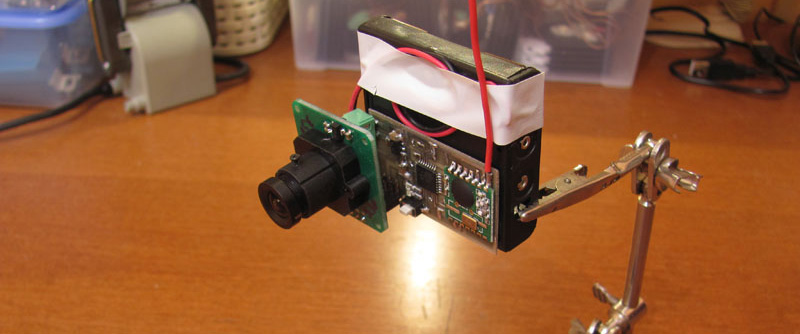All [val3tra] wanted was an RF-accessible camera. A camera that would take pictures, save them to an SD card, and occasionally send them over an RF link to a computer. This project has grown out of control, and now it has become an open-source camera that’s able to take year-long time-lapse movies.
The build started as a low power camera using an eBay JPEG camera modified for 3.3V. That’s only 640×480, but each frame averages only 48kb – small enough to store a few thousand pictures on a FAT16 formatted SD card. A $4 RF module, an ATMega, and an RTC make up the rest of the build that has a power draw of about 100 Joules per hour. A D-cell has about 60,000 Joules, and a pessimistic estimate of a battery of four in series, two in parallel gives a run time of 200 days.
This build was then improved, bringing the total battery consumption down to about 3.5-4 Joules per frame, or at one frame every 10 minutes, about 24 Joules an hour. That’s impressive, and getting this camera to run longer than a dozen or so months raises some interesting challenges. The self-discharge of the battery must be taken into account, and environmental concerns – especially when leaving this camera to run in a Moscow winter, seen in the video below – are significant.
If you don’t want to go equipment-lite you could seal your DSLR, Pi, and some serious batteries in a weatherproof enclosure.















Geez put a fucking solar cell on it already.
Yes, because solar panels would work so well judging by the video.
They work so well at night and Moscow’s winter gets to much sunlight. Solar cells are are so much less expensive than 2 D cells.
I bet you’re such a nice person to be around. Can’t express yourself without cursing?
Won’t somebody think of the children!!!
In this day and age, the thinking of children openly isn’t the nost secure course of action.
Wow, that degenerated quickly.
It’s not just the children. Many adults, myself included, have no desire to see, hear, or read profanity. It’s my opinion that the use of profanity is a sign of a limited vocabulary.
Same here, I’ve long considered profanity to be the language of the uneducated or otherwise dimwitted.
I have quite an extensive vocabulary! I know profanities in at least five languages.
“The sort of twee person who thinks swearing is in any way a sign of a lack of education or a lack of verbal interest is just a fucking lunatic.”
― Stephen Fry
Although many don’t agree on his technical know how, I wouldn’t say his vocabulary is “limited”. If you think some words are naughty and you’re past the age of 5 I think you should really have a good think about your thought processes. If you think some words are bad because a magical sky daddy says they are bad you should have a good long think.
There’s already a measure of power usage called “Ampere hours” perhaps you can convert all the joules references to it?
Strictly speaking A-Hr is not a unit of *power usage* measurement. It is more a battery capacity in the sense that it is the sum of amount of current delivered multiplied by the time where energy has the extra battery voltage term in it.
any link to the camera module? i am tempted to build one !!!
It’s in the linked blog: http://www.ebay.com/itm/TTL-Interface-Camera-Module-CF0706C-V3-JPEG-CVBS-MCU-UART-/181550946094
It would be interesting to see a project like this done with a film camera, maybe super8 or something similarly cheap, according to my calculations at 1 frame every 10 minutes like this project a year could be captured in less than 40 minutes (24 frames per second) of film, that would be interesting. Oh yes, before I forget f*ck, f*ck, f*ck, f*ck, f*ckadee f*ck, f*ck,.
Joules are units of energy.
Watts are units of power.
And I wrote ‘joules per hour’. Not seeing a problem here.
Reading about a year-long time lapse camera reminds me of the “longnow” clock, which is supposed to run for 10,000 years (http://longnow.org/clock/). You have to start thinking LONG-term. Which means of course you can’t be storing pictures on anything as ephemeral as flash memory. Maybe the pictures can be engraved in gold leaf on a quartz substrate, or something. Or since we’re going for the appearance of fast motion, they could be engraved on the inner surface of a huge quartz cylinder with slots cut in it to make a zoetrope (http://en.wikipedia.org/wiki/Zoetrope). A 10,000-year camera making a time-lapse of one picture per day would need 3,652,500 frames. Power can be from various sources, such as a barometric clockwork or something similar wound up by the daily thermal cycle. Now you have to be thinking in joules per century.
That, or I’m just a feature creep.
Reading about a year-long time lapse camera reminds me of the “longnow” clock, which is supposed to run for 10,000 years (https://airporttaxis.com/en/taxi-frankfurt-am-main-airport/). You have to start thinking LONG-term. Which means of course you can’t be storing pictures on anything as ephemeral as flash memory. Maybe the pictures can be engraved in gold leaf on a quartz substrate, or something. Or since we’re going for the appearance of fast motion, they could be engraved on the inner surface of a huge quartz cylinder with slots cut in it to make a zoetrope (https://airport-taxis.be/luchthavenvervoer-zaventem/). A 10,000-year camera making a time-lapse of one picture per day would need 3,652,500 frames. Power can be from various sources, such as a barometric clockwork or something similar wound up by the daily thermal cycle. Now you have to be thinking in joules per century.